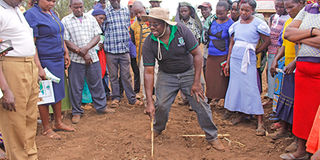New farming method brings cheer and cash

Participatory Approaches for Integrated Development (Pafid) field officer Josphat Muema trains farmers on conservation agriculture. The organisation is promoting conservation agriculture in bid to revive soil fertility and fight climate change. PHOTO|DAVID MUCHUI|NMG
What you need to know:
- This kind of farming involves minimum tillage, retaining crop residue as mulch, crop rotation, intercropping as well as proper use of herbicides, pesticides and other chemicals.
- According to the United Nations Food and Agriculture Organization (FAO), land-use conversion and soil cultivation are responsible for about a third of greenhouse gas emissions worldwide. The UN agency says agricultural soils are among the planet’s largest carbon reservoirs and with a potential to store even more.
- Scientists estimate that soil holds about 2,400 gigatons of carbon, with many studies recommending the planting annual crops and reducing tillage as a way of retaining soil carbon
Four years ago, Peris Wamaitha was a distraught farmer, only managing a meagre two bags of maize from her one-and-half acre piece of land. Located on a steep slope in Kaithe, about nine kilometres from Meru town on the Maua road, the once unproductive land now yields up to 15 bags of maize on half an acre, thanks to conservation agriculture.
This kind of farming involves minimum tillage, retaining crop residue as mulch, crop rotation, intercropping as well as proper use of herbicides, pesticides and other chemicals.
Floods controlled
“Soil is a major carbon sink and its continued turning for planting greatly contributes to climate change,” says Nixon Wafula, a field officer at Participatory Approaches for Integrated Development (Pafid). which is promoting the model as a key weapon in reviving soil fertility and addressing the effects of global warming.
“We encourage farmers in the country to abandon the disc plough and instead use a ripper or a hoe. A disc plough creates a hard pan in the soil, greatly increasing the chances of erosion.”
According to the United Nations Food and Agriculture Organization (FAO), land-use conversion and soil cultivation are responsible for about a third of greenhouse gas emissions worldwide. The UN agency says agricultural soils are among the planet’s largest carbon reservoirs and with a potential to store even more.
Scientists estimate that soil holds about 2,400 gigatons of carbon, with many studies recommending the planting annual crops and reducing tillage as a way of retaining soil carbon. Wamaitha says before started practising conservation agriculture in 2015 after being trained by Pafid, a non-governmental organisation, her homestead could often be engulfed in floods during the rainy seasons. “I was giving up on farming. When I was introduced to conservation agriculture, I tried it on half an acre,” the widow said.
“Harvesting 15 bags of maize on half an acre piece without much labour was a pleasant surprise. Since then, I don’t plough my farm. I conserve the soil instead.” Wamaitha only makes holes with a jembe ahead of planting as opposed to hiring a disc plough tractor to prepare the land.
The recommended spacing between planting holes is 70 centimetres and a metre between the rows. “I stopped flooding through this kind of farming. It also reduced the cost of production and increased my yields,” she said.
He says despite the poor rains last season, he harvested two bags of beans, a high value crop. My neighbours and many other villagers have also embraced conservation agriculture after witnessing my progress.”
Rippers distributed
Once the crops have grown, shallow weeding is recommended so as not to disturb the soil. Wafula says Pafid encourages farmers to use tractor or animal drawn rippers.
“Unfortunately, rippers remain idle in many parts of the country,” he says, adding that a ripper breaks the hard pan and cuts the soil at the point of planting only, thus reducing disturbance.
“This allows the soil to absorb and retain rain water for long. It means erosion is reduced and the soil can sustain the crops for long periods. The crop residue left on the farm helps reduce the loss of water, besides providing organic manure. However, one must also adhere to good agricultural practices to guarantee a good harvest.”
According to Wafula, climate-smart agriculture reduces the cost of production from about Sh4,200 to Sh1,900 per acre. Josphat Muema, a field officer at Pafid, says the use of conservation friendly machines in Meru County is being hampered by poor access to rippers.
Last week, FAO and European Union officials distributed rippers, subsoilers, shallow weeders, planters and many other equipment to residents of Meru and Tharaka-Nithi counties to promote conservation agriculture. FAO has also been training farmers on conservation agriculture under a programme dubbed Increased Productivity and Profitability-Good Agricultural Practices (IPP-GAP).
A recent survey by agronomists from the Kenya Agricultural and Research Organisation (Kalro) on conservation agriculture showed that it increases maize and beans production by 30 per cent.
According to the research, farmers who use conservation agriculture improve maize yields from 1.6 tonnes to 4.5 tonnes per hectare while bean production rose from 0.5 to two tonnes.




